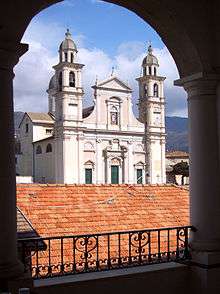Lavagna
| Lavagna | ||
|---|---|---|
| Comune | ||
| Città di Lavagna | ||
 | ||
| ||
 Lavagna Location of Lavagna in Italy | ||
| Coordinates: 44°19′N 09°20′E / 44.317°N 9.333°ECoordinates: 44°19′N 09°20′E / 44.317°N 9.333°E | ||
| Country | Italy | |
| Region | Liguria | |
| Province / Metropolitan city | Genoa (GE) | |
| Frazioni | Barassi, Cavi di Lavagna, Santa Giulia di Centaura, Sorlana | |
| Government | ||
| • Mayor | Paolo D'Attilio (commissar) | |
| Area | ||
| • Total | 13.7 km2 (5.3 sq mi) | |
| Elevation | 6 m (20 ft) | |
| Population (30 September 2012)[1] | ||
| • Total | 12,510 | |
| • Density | 910/km2 (2,400/sq mi) | |
| Demonym(s) | Lavagnesi | |
| Time zone | CET (UTC+1) | |
| • Summer (DST) | CEST (UTC+2) | |
| Postal code | 16033 | |
| Dialing code | 0185 | |
| Patron saint | Madonna del Carmine | |
| Saint day | 16 July | |
| Website | Official website | |
Lavagna is a tourist port city in the curving stretch of the Italian Riviera di Levante, called the Gulf of Tigullio, in the Metropolitan City of Genoa in Liguria. The borgo of Lavagna was an important Ligurian cultural center in the Middle Ages. Today its long straight beach is a summer resort.
History
Lavagna developed in Roman times as Lavania. According to some historians, it was seat of a countship since Carolingian times. From 1198 it was a fief of the Fieschi family, who used Lavagna as their stronghold in the numerous inner struggles of the Republic of Genoa.
In 1564 it was sacked by the African pirate Dragut. From 1815 it was part of the Kingdom of Sardinia, and, later, of the Kingdom of Italy.
The mayor of Lavagna, Giuseppe Sanguineti, was arrested on 20 June 2016 due Mafia affairs.[2]
Main sights

- Basilica of Santo Stefano (17th century)
- Basilica of Santa Giulia (1654)
- Sanctuary of Nostra Signora del Ponte (13th century), with the nearby bridge. It was enlarged by the Fieschi Pope Innocent IV, being consecrated in 1492. It has been largely renovated in the 19th century. According to the tradition, Dante Alighieri crossed the bridge during his voyage to France.
- Torre del Borgo, a Medieval tower now housing the local art gallery.
Culture
The city recreates neo-medieval festivities annually as the "Torta dei Fieschi", which has been recreating (since 1949) the festivities that surrounded the wedding in 1230 of Opizzo Fieschi, Conte di Lavagna, older brother of Sinibaldo, future Pope Innocent IV, with the Sienese patrician Bianca de' Bianchi. A colorful cortege through the streets reunites the inhabitants of the six medieval quarters (sestieri) of Lavagna, as the gigantic cake is distributed among those in the crowd who have found the matching half of their tickets.
The characteristic shale that provides roofing "slates" in Liguria was traditionally quarried in the Capenardo and S. Giacomo mountains nearby.
People
- Fieschi family
- Fanny Cadeo, (1970) actress and showgirl
See also
- Prince Belmonte
- Tigullio
References
- ↑ All demographics and other statistics: Italian statistical institute Istat.
- ↑ http://www.ilfattoquotidiano.it/2016/06/20/ndrangheta-traffico-illecito-di-rifiuti-in-liguria-arrestato-il-sindaco-di-lavagna-e-unex-parlamentare-udc/2845065/
External links
- "Torta dei Fieschi" (Italian)
